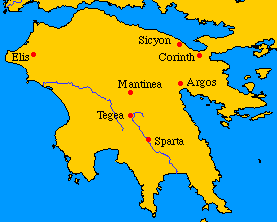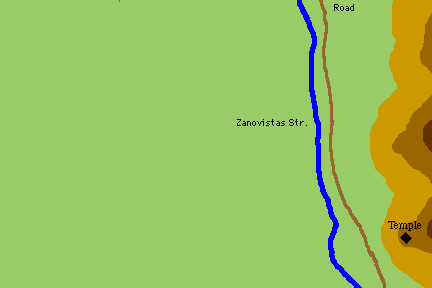Luke Ueda-Sarson's Historical Battle Scenarios for DBM:

The First Battle of Mantinea: 418 BC





In 419 BC, the Argives attacked the Epidaurians, a minor state allied to Sparta, the traditional enemy of Argos. The Spartans gathered a powerful army and marched to Argos, where King Agis, the Spartan CinC, negotiated a 4-month truce with the Argives. This incensed many of his allies, as well as the Spartans government, who thought a golden opportunity to crush Argos had been wasted.
The Athenians, at war with the Spartans, however managed to convince the Agives to break the truce. They prepared to march against Tegea, where a pro-Allied party was formenting a revolt. Alarmed, the Spartans marched northwards to confront the Allies. Agis' previous leadership had been harshly criticesd, and he was determined to score a military success. The Allies took up a strong defensive position on a hill which Agis wished to attack, but he was persuaded to delay the assault. Instead he retreated, and started laying waste to the area and disrupting the irrigation works. The Allied common soldiers pressed their generals to advance, and next day suddenly arrived at Agis' position in full battle array, giving the Spartans precious little time to adopt their own battle formation.
The ensuing battle was a somewhat confused affair, with both sides losing in places, but eventually the Spartans gained the upper hand and carried the day, restoring somewhat their miltary credentials, but making no important stratetegic gains other than a peace teaty with Argos.

At the usual scale of 250 men per element, the opposing forces can be conjectured as the following:
The Spartan side
1 x Reg Cv (I) - Spartan cavalry
1 x Reg Sp (S) Sub-general
1 x Reg Sp (S) - Other Sciritae
4 x Reg Sp (O) - Peloponnesian mercenaries from Brasidas' old command in Thrace
4 x Reg Sp (I) - Neodamodeis
8 x Reg Sp (I) - Helot hoplites
4 x Bg (I) - Spartan wagons and old men
1 x Reg Sp (S) CinC - Agis and the Spartan Hippeis
13 x Reg Sp (S) - Other Lacedaemonians
4 x Irr Ps (I) - Helots fighting as psiloi
8 x Irr Sp (O) - Heraean and Maenalian Arcadians
12 x Irr Sp (O) - Tegeans
3 x Irr Ps (I) - Tegean servants armed as psiloi
2 x Reg Sp (O) - Tegeans plus a few Spartans forming the end of the line
1 x Reg Cv (I) - Spartan cavalry
The Spartan side comes to 329 AP, the first command breaks on 6.5, the second on 13.5 and the army breaks on 30.
The Allied side:
1 x Irr Sp (O) Mantinean ally-general
11 x Irr Sp (O) - Mantineans
4 x Irr Sp (O) - Allied Arcadians
2 x Irr Bg (I) - Mantinean servants with supplies
3 x Irr Ps (I) - Mantinean servants armed as psiloi
4 x Reg Sp (S) - Argive Logades (picked men trained by the state)
1 x Irr Sp (O) Argive CinC
15 x Irr Sp (O) - Argves of the '5 Companies' and the older men
2 x Irr Sp (O) - Argive allies from Cleonae and Ornea
2 x Irr Bg (I) - Argive servants with supplies
4 x Irr Ps (I) - Argive servants armed as psiloi
4 x Irr Sp (O) - Aeginetans
1 x Irr Sp (O) ally-general - Laches the Athenian
3 x Irr Sp (O) - Athenians
2 x Irr Bg (I) - Athenian servants with supplies
2 x Irr Ps (I) - Athenian servants armed as psiloi
2 x Reg Cv (I) - Athenian Hippeis under Nicostratus
1 x Irr Sp (O) Elian ally-general
11 x Irr Sp (O) - Elians
4 x Irr Sp (O) - Athenians
2 x Irr Bg (I) - Elian servants with supplies
3 x Irr Ps (I) - Elian servants armed as psiloi
The Allied side comes to 304 AP; the Mantinean command breaks at 7.5, the Argives at 8.5, the Athenians at 4 and the reinforcements (Eleians and Athenians) at 6. The Allied army breaks at 35.
The Sciritae were recruited from just north of Sparta. Because the Sciritae were hillmen, some have claimed they were light-armed - but this doesn't seem to match with Diodoros' description of them (15.32.1) as an elite reserve. They were 600 strong at Mantinea (5.68, unless noted, all references are to Thucydides).
Brasidas went with 1700 hoplites to Thrace (4.78, although he had 2000 by the battle of Amphipolis, 5.6). Of these, 700 were helots, the rest Peloponnesian mercenaries (4.79). The Brasidan helots were later freed for their services (5.34). The Spartans brought great numbers of helots to the battle (5.64), presumably most of these also fought as hoplites as Brasidas' helots previously, otherwise it is hard to see how the Spartans could have even come close to outnumbering the Allies. As it is, I have had to assumes the Allies must have formed up deeper than the 8 ranks the Spartans averaged, otherwise the only explanation of how the Sparta line was longer than the Allied is that Thucydides has ommitted some contingents from the Spartan order of battle.
Thucydides calculates the Spartans themselves, excluding the Sciritae, were about 3500 strong, divided into 7 lochoi. Th numbers of the Arcadian allies are unknown, I suggest 2000 in total, as Herae and Maenalia were not large states. (I would have estimated them as smaller still if it wasn't for the Spartan line being longer...)
At Nemea in 394 BC, the Tegean contingent was likely at the very least 2400 strong (since they were facing off at least 40% of the 6000-strong Athenians, Xenophon's Hellenica 4.2.19). Here, fighting on their very doorstep, they are likely to have numbered even more - so I would estimate them as being 3500 strong. They formed up on the right, since they were fighting at home.
The Mantineans too formed up on the right of their side, fighting at home. I have grouped the 1000 picked Argives with them since they continued fighting alongside the Mantineans when the rest of the Argives broke. Since these men were associated with the Oligarchic faction (at least later on) while most rest of the Argives were democratic, they may have prefered to associate with the Mantineans than their own compatriots.
Argos was a powerful and populous city, and could certainly field more men than Corinth (who had put 5000 into the field at Plataea, admittedly long ago when Corinth was more powerful, they had fielded just 2000 a few months previously to the battle, 5.57). I therefore put them at 5000, including the picked troops. Their allies were small towns, and would not have fielded many men. None of the allies had any cavalry save the Athenians (5.59)
The Athenians sent only a small portion of their forces. Previously they had sent out 1000 hoplites under Alcibiades (5.55), but these had returned home. 1000 hoplites and 300 horse had arrived as reinforcements under Laches and Nicostratus (5.61), both of whom died in the battle. Aeginetans are mentioned as fighting with them (5.74), Aegina was perviously powerful, but now much reduced, estimate them being no more than 1000 strong. The 300 horsemen get the benefit of called 2 elements rather than due to the notable effect they had in aiding the retreat of the Athenians.
As 1000 more Athenian hoplites arrived after the battle along with 3000 hoplites from Elis, the Allied side must to dice for these reinforcements as if for a flank march, except that they arrive on the road at the Allied rear table edge rather than a side table edge.
Fighting the battle:
The Spartan side faces north, the Argives and their allies face due south. The season is autumn, the climate warm. Determine the time of day and weather in the usual manner - due to the inconsistencies of Agis' leadership, the battle could have happened at any time. Since the Allied side caught the Spartans off guard, they will count as the invader and take the first move (5.66). All allies have been proven reliable by the previous days' skirmishing so reroll any initial PiP die scores of1 by on-table ally-generals (the Eleians might be more unreliable having argued with the other allies previously, 5.62; none of the allied contingents should count as 'foreign' allies however, so they will not desert).

A number of small riverlets cut the plain between Mantinea and Tegea. They would normally have been totally dry at this time of year, but Agis had just engaged in some water-diverting operations to coax the Allies south, and some might have still held water from this, especially the Zanovistas to the east which the road ran by. However, as none of them seem to have had any effect on the battle they ones cutting across the field are best ignored. The Xanovistas should be depicted as a very narrow stream, less than the depth of a single Sp element wide, and classified as paltry. The plain is bounded on both sides by hills, and as the Spartans had previously encamped by the temple of Heracles (too small to count as a BUA in DBM) on the eastern hills to which they now returned, these will appear on the battlefield. Count them as gentle, with occasional steep and/or rocky sections
Fight the battle until one side is broken. If the Spartans side is broken, the allies win an overwhelming victory, unless they themselves break that same bound in which case they win a marginal victory. The Spartans only win an overwhelming victory if they break the allies without having a command demoralised, and if they lose no more than 2 elements of Sp (S). The Spartans are expected to win, and outnumber the enemy: anything less will reinforce their recent 'signs of weakness' in the eyes of the Greek world. Losses of Spartan citizens must always be minimised. The Spartans win a marginal victory if the break the allies without having a command broken but lose more than 2 elements of Sp (S), or they lose no more than 2 elements of Sp (S) but do have a command broken. Any other result is a draw.
Notes and special rules:
In DBM v3.0, two opposing elements of Sp (S) count the (S) bonus, which is not such good thing for hoplite battles, as it means they can't kill each other; so when Sp (S) meets Sp (S), I suggest that neither counts as (S) - they should retain the (S) bonus against all other opponents however. I would also propose that two opposing elements of the same type that BOTH have generals don't count the generals' + 1 tactical factor. Greek generals seemed to have regularly died in the front ranks, which is very hard to do at factor 6 even if doubly overlapped.
This page last modified: October 6, 2000
